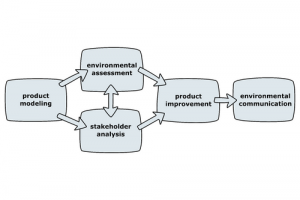Lesson 8 – Eco design
The eco-design process, also known as ecological design or sustainable design, is a systematic approach to creating products, buildings, or systems that have minimal negative impacts on the environment throughout their entire lifecycle. It aims to integrate environmental considerations into the design process to reduce resource consumption, energy use, waste generation, and pollution.
The steps of the eco-design process which are applicable to product improvements as well as new developments.
The eco-design process typically involves the following key steps:
- Identification of Objectives: At the outset, the design team defines the project’s objectives, including the desired environmental performance and sustainability goals. This step sets the direction for the entire eco-design process.
- Life Cycle Assessment (LCA): LCA is a crucial step in eco-design, where the environmental impacts of the product or system are assessed throughout its entire lifecycle. This includes raw material extraction, manufacturing, transportation, use, and end-of-life disposal. LCA helps identify hotspots of environmental impact and potential areas for improvement.
- Design Strategies: Once the environmental impacts are identified through LCA, the design team explores and implements various strategies to minimize these impacts. This might involve selecting more sustainable materials, optimizing energy efficiency, reducing waste generation, improving recyclability, and considering the social and ethical aspects of the design.
- Collaboration and Integration: Eco-design often requires collaboration between different stakeholders, including designers, engineers, suppliers, and experts in relevant fields. Integrating various perspectives and expertise is essential to develop a holistic and environmentally friendly design.
- Prototyping and Testing: Before full-scale implementation, prototypes are created and tested to validate the eco-design concepts. This step helps identify any design flaws or potential issues that need to be addressed before mass production or construction.
- Implementation and Production: Once the eco-design has been thoroughly tested and optimized, it moves into the production or construction phase. Here, it is essential to ensure that the environmentally friendly features are properly implemented and that the final product meets the desired environmental standards.
- Monitoring and Improvement: After the product or system is launched or put into use, continuous monitoring is crucial to assess its actual environmental performance. Feedback from users and data on energy use, resource consumption, and waste generation can help identify areas for improvement in subsequent design iterations.
- End-of-Life Considerations: Eco-design also emphasizes planning for the end of a product’s life. This involves considering options for recycling, upcycling, or safely disposing of the product to minimize its impact on the environment when it becomes obsolete.

Fig. 9: The steps of the eco-design process which are applicable to product improvements as well as new developments. Available at: https://www.tuwien.at/en/mwbw/ikp/klft-ecodesign/ecodesign/about-ecodesign
Lesson 8, Inspired by: https://www.tuwien.at/en/mwbw/ikp/klft-ecodesign/ecodesign/research-projects/awareness-building/ecodesign